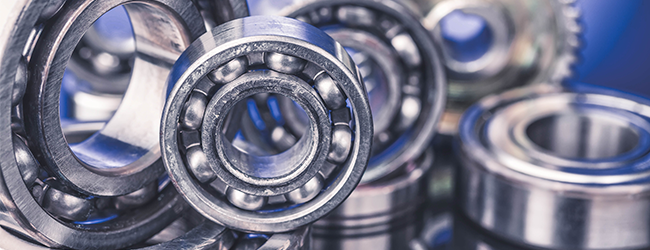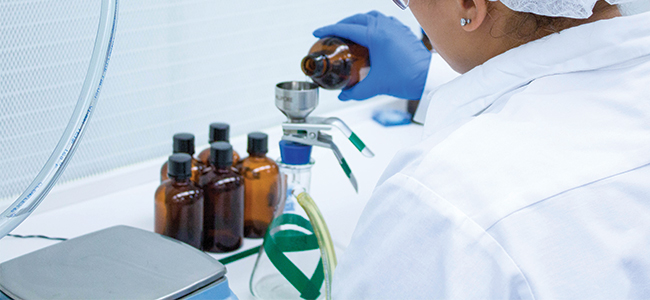5 Things to Consider When Selecting a Precision Bearing Lubricant
Precision bearings are used in a variety of industries where tight tolerances are required to optimize performance and negate risk. In the Industrial, Aerospace, Medical, and Semicon industries, the failure of precision bearings can be expensive and/or safety critical. According to Machinery Lubrication, as many as 60 to 80 percent of all bearing failures can be attributed to a contaminated, poorly selected, degraded, or poorly applied lubricant. This means that lubricant performance plays a critical role in ensuring how well, and for how long, a lubricant can minimize friction to prevent wear that leads to bearing failure.

Often, an improperly selected lubricant is to blame. Because precision bearings are manufactured with tight tolerances, there is little room for failure; meaning that your lubricant must meet the unique requirements of your specific application. There are several factors to consider when selecting the proper precision bearing lubricant.
Temperature
When a lubricant degrades, it is often because it cannot withstand the temperatures of an application. In these situations, high temperatures can cause the lubricant to polymerize, creating a tacky substance that could act like a “speed bump” in the raceway of the bearing which causes vibration and ultimately wear. Even if the lubricant simply evaporates under high temperatures, there is no oil to separate the surfaces which allows excessive metal to metal contact and wear. Lubricants with operating temperatures above 300°F, or non-burning lubricants should be considered in high temperature applications.
Contamination
Microscopic contaminants can also act as impediments and are equally as detrimental to bearing performance, particularly within vacuum and cleanroom applications, as they can contaminate other components nearby. Solid particles in lubricants come from many sources, but the most likely culprits are raw materials, the manufacturing process, and the environment. While lubricants are selected for their physical properties, such as temperature range, penetration grade and additive fortification, cleanliness should also be considered. The cleanliness of a grease is described by the number of particles within size ranges, in which the particles are counted under a microscope and are determined by the largest dimension in microns. The best way to ensure lubricant cleanliness is through ultrafiltration. Ultrafiltration is a rigidly controlled filtering process that reduces microscopic particulates in a lubricant. The objective of this process is to remove unwanted substances or contamination from the grease or oil.

Nye has ISO class 8 and class 7 certified clean rooms that are strictly regulated to prevent cross-contamination of any kind. Nye offers ultrafiltration services for not only our own greases, but also for those produced by other manufacturers. At Nye, we ensure ultraclean grease by following a strict manufacturing process from start to finish.
Load
Precision bearings supporting high loads demand a lubricant with excellent film strength to ensure metal surfaces remain separated and prevent wear. For higher loads, especially where vibration or shock loading is likely, special anti-wear additives can improve grease performance.
Speed
High and low speed applications require lubricants with different properties. High speed applications require a grease with an appropriate base oil viscosity and special thickeners. Low speed applications with little friction may only require oil lubrication. Nye also offers NyeBar®, a unique polymer which can be used on the bearing faces to prevent oil migration and leakage.
Dispensing
Caution should be taken to ensure that a bearing is not under- or over-filled. This requires a dispensing method that distributes the grease precisely. This may mean that you need a syringe for manual application or pails for automated dispensing. Nye offers referrals to companies that provide dispensing systems to help customers choose the right application procedure.
Often, it is not until there is a high percentage of rejects or, worse, failures in the field that the spotlight turns toward the lubricant. Carefully considering which lubricant to fill your precision bearing during the design phase will greatly reduce your risk for product failure.
| Grease | Chemistry | Temperature Range (°C) |
4-Ball Wear Scar | Application Notes |
|---|---|---|---|---|
| NYETORR 5200 | Cyclopentane/ PTFE |
-45 to 150°C | 0.59 mm | Low outgassing and particle generation grease intended for semiconductor manufacturing equipment. |
| RHEOLUBE 2000 | Cyclopentane/ Sodium Soap |
-45 to 125°C | 0.38 mm | Aerospace and other low vapor pressure applications. |
| RHEOLUBE 462 | PAO/ Lithium Soap |
-54 to 130°C | 0.51 mm | General purpose bearing grease with great oxidative stability and corrosion resistance. |
| UNIFLOR 8172 | PFPE/ PTFE |
-45 to 225 °C | - | Excellent plastic and elastomer capability with resistance to aggressive chemicals. |
| UNIFLOR 8981 | PFPE/ PTFE |
-65 to 250°C | 1.67 mm | Excellent thermo-oxidative stability and low vapor pressure characteristics. |

